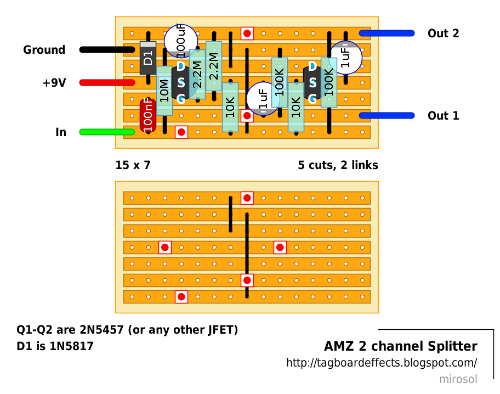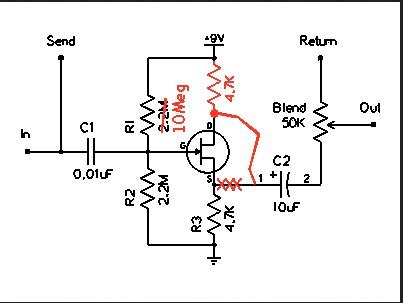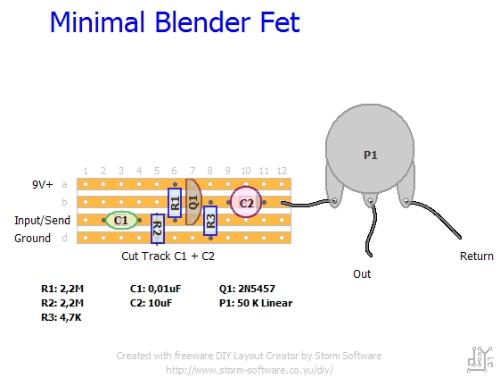simpliest mixer
|
This post was updated on .
Hi folks,
is anyone have a circuit for mixing together two signals? i have used this AMZ circuit to split input signal, now i just want to blend them "50/50 fixed" before output, nothing more, nothing less (and in future, if necessary, tweak it to inverting phase).  thank you. i have found this but as is, i don't think it match because is a split'n'blend design and i just need to blend... but thanks to this, i'm starting to see how the phase switching is build.   anyway, i'll test it in case it works |
|
so i've tryed the last schem and it's not working (bad mixing with interferences)
i'm looking at the rog splitter blender and draw this adaptation with one tl072 Do you think it will be work for simply mixing 50/50 the two signals? 
|
|
In reply to this post by El-even
Wouldn't the split 'n blend be a much better circuit for your purposes?
http://tagboardeffects.blogspot.nl/2012/02/split-n-blend.html And if you hate having to use an external pot and knob you could use an internal trimpot to set the signal where you like it and then forget about it ever existing. |
|
This post was updated on .
thanks Muadzin,
the problem is my two signals are already split and i don't hate use pot but just don't have utility in my build I just need to blend the two signals in one and if i do this on the fly (just soldering the two wires together to an output wire) the sound is very bad with lot of interference, so i continue and continue again searching to find a simple circuit wich solve that. At least for testing and if it fail, searching another solution. If i clearly understand the split'n'blend circuit, his goal is to create an "fx loop" to blend an FX to a signal. My goal is different, i want to blend two "effected" signals clear input > split > two FX in parallel > blend > one output mixed |
|
Maybe this is more in line to what you need?
http://tagboardeffects.blogspot.nl/2013/01/2-channel-mixer.html |
|
In reply to this post by El-even
The simplest blend would be to connect the outputs via two identical resistors and take the output from the junction in the middle. Only two components, and it will reduce or eliminate the interference in many cases, at the cost of a little volume. If you choose the smallest resistor value that cures the interference problems (try 1k, 10k, etc.), you can minimize the volume loss (which may or may not be an issue, depending on what you're doing between the splitter and the mixer; you haven't said, so it's hard to predict). Replace the resistors with a pot (signals to 1 and 3, output from 2) and you get a mix control.
If you want to make it more robust, passing each signal through a buffer (like in your diagram above*) should work, or you can use a summing amplifier (i.e. feed the output from the resistors in the first paragraph through an inverting op-amp stage.) Edit: this is the same idea as the circuit Muadzin linked to above. If you need to invert phase, you can add RG's polarity reverser to one of the signal paths. Here's what that might look like, if you modify the ROG circuit you mentioned (just leave off the op-amp at the top left, and connect one signal to 'Input', and the other to 'Return'). I recommend you figure out which option works best for you on the breadboard before you start making veros. The pair of resistors is certainly the simplest solution, but whether it's best depends on the rest of your circuit. * BTW, the pair of buffers you posted is mostly the same idea as the split'n'blend, but with some very minor tweaks. You could easily adapt the split'n'blend vero to do exactly the same thing as the op-amp mixer, if you were so inclined. |
|
Very, very thanks friends,
with the two resistors (32k) it works O_O' so, definitly the most simpliest mixer winner  i will try with lowest values i have also tryed the phase invertor but don't heard difference (maybe fail to build it) so i give up . |
|
I'm glad it worked.
The phase inverter is good for fixing phase problems (mainly signal cancellation), but the results depend on the signals being mixed. If the two signals are very different, flipping the phase of one of them might be undetectable. Mixing a fuzz signal with a dry signal that has opposite polarity will subtract the dry signal from the fuzz, making it even fuzzier, while mixing them in phase will usually make the result louder and less fuzzy. If you flip the phase of a single signal (without mixing it with another signal), you won't hear any difference. |
«
Return to Open Chat
|
1 view|%1 views
| Free forum by Nabble | Edit this page |

